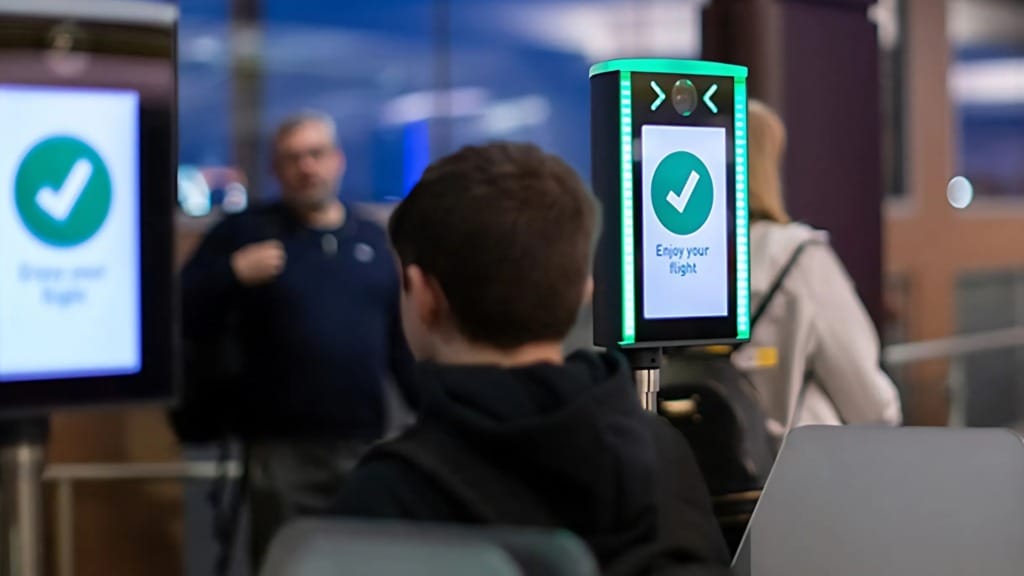Air travel is on the cusp of a revolution, driven by technology that promises to redefine our journey through airports. Imagine a future where the hassle of physical passports becomes a distant memory, replaced by seamless, biometric-driven systems. This isn’t science fiction; it’s the rapidly approaching reality of passport-free travel. Airports around the globe are increasingly adopting sophisticated biometric technologies, including facial recognition, fingerprint scanning, and iris detection, aiming to enhance security, expedite passenger flow, and fundamentally transform the travel experience.
As we witness the rise of these innovations, we can anticipate significant improvements: shorter queues at security and immigration, a diminished need for paper documents, and a more streamlined passage from check-in to boarding. However, this progress is not without its complexities. Questions surrounding data privacy, security of sensitive biometric information, and the need for international standardization are paramount. This article delves into the transformative power of biometric technology in airports, examining its benefits, the challenges it presents, and the trajectory towards a future where passport-free travel becomes the norm.
How Biometric Technology is Reshaping Airports
At its core, biometric technology leverages unique biological traits – your face, fingerprints, iris patterns – to instantly and accurately verify your identity. Unlike traditional identity documents which can be susceptible to fraud, biometric data provides a far more secure and reliable method of authentication. Airports are strategically integrating these systems throughout the passenger journey, striving for a frictionless and paperless travel ecosystem.
A prime example is Singapore’s Changi Airport, a pioneer in adopting facial recognition technology. Passengers can now glide through immigration checkpoints in as little as 10 seconds. This efficiency is achieved through advanced cameras that capture and compare facial data against secure government databases, effectively eliminating the need for manual passport checks. According to a report by Bloomberg, this system has significantly reduced congestion and enhanced passenger satisfaction.
Similarly, Australia and New Zealand have implemented SmartGate systems, automating border control with facial and fingerprint scans. These initiatives, as highlighted by the New Zealand Government, have substantially cut down on passenger waiting times and streamlined border processes.
Taking innovation even further, Abu Dhabi’s Zayed International Airport is ambitiously aiming to become the world’s first airport to fully integrate facial recognition across every stage of the passenger journey. By 2025, as reported by Abu Dhabi Media Office, the airport anticipates a completely touchless travel experience where passports and boarding passes are rendered obsolete, with biometric verification powering all processes.
However, realizing the full potential of these systems requires overcoming the challenge of global harmonization. The diverse range of technologies currently in use across different airports can lead to inconsistencies, particularly for international travelers who may still face manual checks in some locations. Furthermore, the widespread adoption of biometric technology necessitates substantial investment in infrastructure and technology upgrades. While major hubs like Changi and Abu Dhabi are leading the way, smaller airports may find it challenging to replicate these advancements due to financial and logistical constraints. Despite these obstacles, the compelling advantages of biometric systems are propelling their rapid adoption on a global scale.
The Multifaceted Benefits of Biometric Travel Systems

Image credit: SITA
Biometric systems offer a wide array of benefits that significantly enhance airport operations and passenger experiences. Efficiency tops the list. By leveraging biometric verification, airports can dramatically reduce passenger processing times at critical checkpoints like immigration, security, and boarding gates. This expedited flow minimizes queues and congestion, making the airport journey smoother and more time-efficient for travelers.
Enhanced security is another paramount advantage. Biometric data, being unique to each individual, offers a robust defense against identity fraud and impersonation. Airports equipped with these systems can more effectively verify passenger identities, ensuring that only authorized individuals gain access to secure zones and aircraft. This heightened security layer contributes significantly to overall aviation safety.
Operationally, biometric systems enable airports to manage increasing passenger volumes without necessitating a proportional increase in staffing levels. This is especially crucial during peak travel periods when airports experience high traffic. The automation capabilities of biometric technology allow for streamlined processes, optimizing resource allocation and improving overall operational efficiency.
Passengers also gain from personalized and convenient travel experiences. Biometric integration with airline and airport mobile apps provides travelers with greater control over their journey. Passengers can manage their travel credentials digitally on their smartphones and even pre-clear certain security checks before arriving at the airport. This proactive approach reduces stress and saves valuable time at the airport.
Moreover, the real-time data analytics generated by biometric systems offer airports enhanced capabilities in crowd management. By analyzing passenger flow and processing times, airports can identify potential bottlenecks, dynamically adjust staffing levels, and optimize resource allocation, leading to smoother passenger movement and improved airport operations.
Benefits at a Glance
| Benefit | Description |
|---|---|
| Increased Efficiency | Faster processing times at checkpoints, reduced queues and congestion. |
| Enhanced Security | Reduced identity fraud, improved accuracy in passenger verification. |
| Operational Efficiency | Better management of high passenger volumes, optimized staff allocation. |
| Personalized Passenger Experience | Digital credential management, pre-clearance options, smoother journey. |
| Improved Crowd Management | Real-time data and analytics for dynamic resource adjustment. |
Navigating the Challenges of Biometric Technology Adoption
While the advantages of biometric technology in air travel are compelling, several significant challenges must be addressed to ensure successful and responsible implementation. Privacy concerns are at the forefront. Biometric data is intrinsically personal and highly sensitive, necessitating robust safeguards to protect it from unauthorized access and misuse. Passengers must have confidence that their biometric information will be handled with utmost care and in compliance with stringent data protection regulations.
Data security is another critical concern. Biometric databases, containing vast amounts of sensitive personal information, are highly attractive targets for cyberattacks. A data breach could have severe consequences, potentially exposing travelers to identity theft and other forms of cybercrime. Unlike compromised passwords, biometric data cannot be easily changed, making data breaches exceptionally risky and demanding robust security measures.
Achieving global standardization remains a significant hurdle. The current landscape of biometric systems in airports is fragmented, with varied technologies and protocols in use across different countries. This lack of interoperability can create inconsistencies for international travelers, potentially undermining the seamless travel experience that passport-free travel aims to deliver. Organizations like the International Air Transport Association (IATA) are actively promoting global standards, but widespread adoption requires collaborative effort and international agreement.
Technological limitations also present challenges. Current biometric systems may not perform optimally across all demographics. Issues such as variations in skin tones, facial structures, and physical disabilities can lead to reduced accuracy rates and potential biases in recognition, resulting in inconvenience and frustration for certain groups of travelers. Ensuring inclusivity and fairness in biometric technology is crucial for equitable implementation.
Public acceptance is yet another critical factor. Some passengers harbor reservations about sharing their biometric data, often expressing concerns about increased surveillance, potential misuse of data, and erosion of personal privacy. Building public trust requires transparency in how biometric data is collected, stored, and used, combined with robust regulatory frameworks that guarantee data protection and individual rights.
Passport-Free Horizons: The Future of Air Travel
The trajectory of air travel is unmistakably heading towards a fully biometric-driven ecosystem, supported by global initiatives and technological advancements. IATA’s One ID project is a pivotal initiative aiming to establish a universal digital identity for travelers. This ambitious project seeks to create a system where a single biometric token can securely verify a passenger’s identity across all airports and borders, streamlining every step of the journey.
In the not-so-distant future, your biometric profile may be seamlessly integrated with your smartphone or a secure digital wallet. This would empower you with greater control over your personal information, allowing you to selectively share your biometric data with airports and airlines only when necessary. This user-centric approach to data sharing can foster greater trust and confidence in biometric travel systems.
However, realizing this future vision requires concerted international cooperation. Governments, airport authorities, airlines, and technology providers must collaborate to establish uniform technology standards, data-sharing protocols, and robust privacy regulations. This global alignment is essential to create a truly interoperable and integrated biometric travel ecosystem. Without such collaboration, the benefits of passport-free travel will remain fragmented and limited to specific airports or regions.
Furthermore, as biometric technology becomes more pervasive, ethical considerations surrounding ethical data use will become increasingly important. Clear and transparent policies governing data storage, access, and usage are essential to build public trust and ensure compliance with evolving privacy laws. A balanced approach that prioritizes both security and individual privacy will be crucial for the long-term success and public acceptance of passport-free travel.
While significant challenges remain on the path to widespread passport-free travel, the direction is clear. Biometric technology is poised to become the cornerstone of global air travel in the years to come. As these systems evolve to be more sophisticated, secure, and user-friendly, we can anticipate a future where a simple facial scan or fingerprint verification could be all you need to smoothly navigate airports and board your flight, ushering in a new era of seamless and efficient global mobility.

